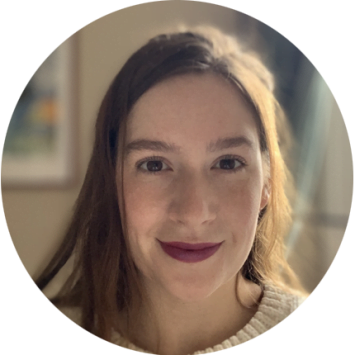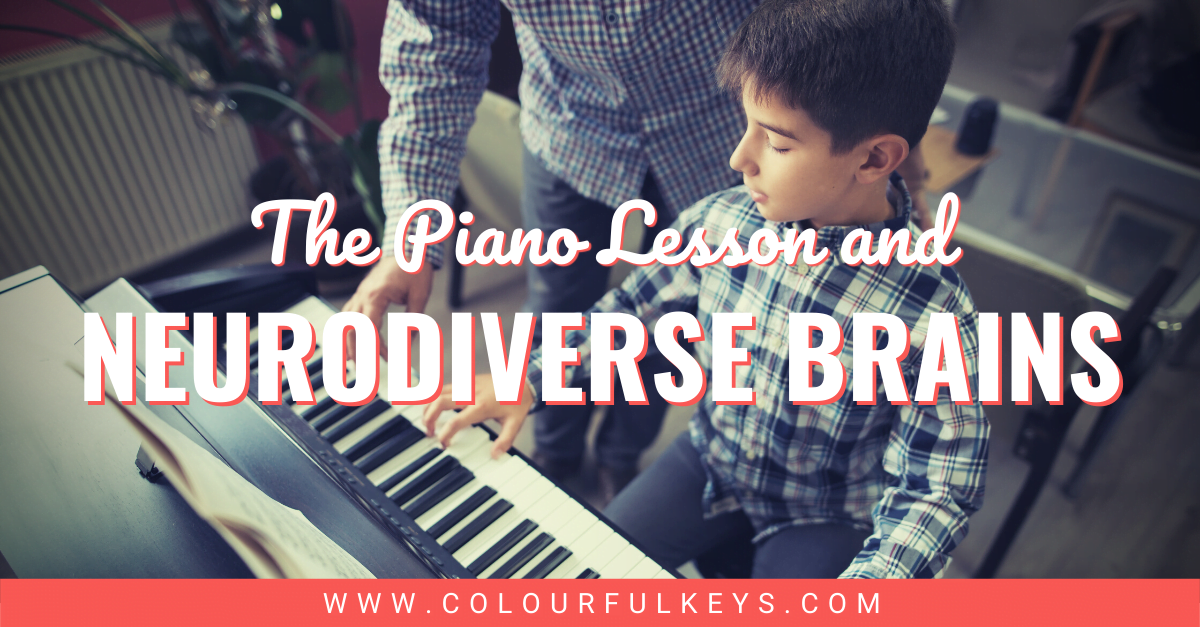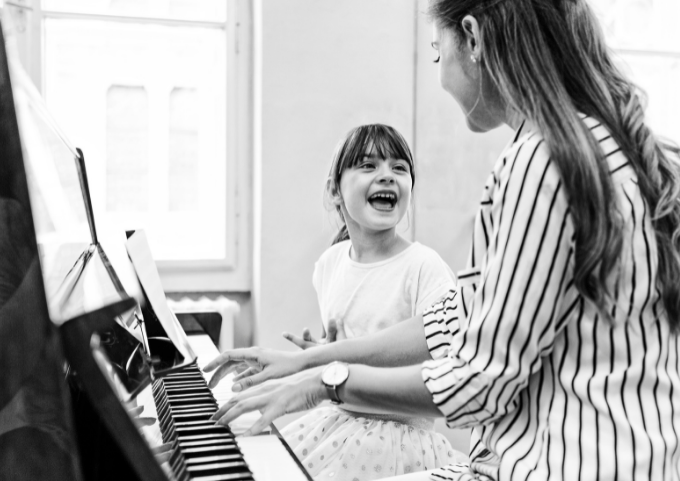
This article about understanding neurodivergent piano students was written by Joanna Shiel. Joanna runs a piano school in London, UK and has been teaching a wide range of neurodiverse students for 13 years. She is enthusiastic about the ways music can be used as therapy for all and every kind of student. Her Dessert of the Month is rose jam-filled doughnuts.
Have you ever been frustrated when a student struggles to learn something which other students seemingly pick up without any trouble? If so, you’re not alone – and it doesn’t mean you’re failing as a teacher. You may, however, benefit from adjusting your approach just a bit.

It’s a simple fact that people all think, learn and behave differently according to the way our brains process information. This is called ‘neurodiversity.’ When a student is neurodivergent, it simply means they think, behave and learn differently than a typical student.
Neurodivergence is something every teacher will likely encounter at some point in their career. And when you have a student who is different, it can be overwhelming, and you can easily feel discouraged.
Fear not!
In this article, we’ll explore some commonly-recognized types of neurodivergence and how to work with these students in your piano studio.
Note: If you already know the diagnosis, feel free to jump ahead to that section of this article:
3 Types of Neurodivergence Commonly Encountered in Piano Students
There are 3 common types of neurodivergence which I have experienced during my time as a piano teacher. While every student is different, there are some generalities which may help you work better with these students.
1. Autism Spectrum Disorder (ASD)
ASD is an umbrella term which now officially (to the best of my knowledge) encompasses conditions we used to know as Asperger’s syndrome and autism. Some kids may still come to you with an Asperger’s diagnosis, but most younger kids will have now been diagnosed with ASD.
Attributes of Students with ASD
ASD has a wide range of effects on a person, with some people experiencing mild symptoms and others more extreme. But in general, an ASD diagnosis means the child might display some of the following attributes:
- Delayed speech development and preferring to speak in shorter sentences or not speak at all
- Not responding to their name being called and avoiding eye contact
- Not picking up on sarcasm or implications – taking what people say very literally
- Behaviour which may seem rude due to not picking up on social conventions
- Highly-specific interests in particular subjects and disinterest in areas outside this specialty
- Strong preference for following routines
- Sensory processing issues such as difficulty dealing with certain textures, too much brightness or too many stimuli
Challenges in Piano Lessons
Students with ASD will need support to work on their reading skills in addition to developing their musical ear. They often need to be reminded that it’s not about getting it right but also about creating a musical flow to the music, which means not stopping and starting over and over but following through.
Improvisation and compositional skills will need work. In my experience, students with ASD struggle with coming up with different ideas and will need lots of encouragement and support.

They can also struggle with working with you as a teacher. Make sure to nip any bad behaviour, words, language and body language as soon as it appears in a lesson – it is not always obvious to people with ASD that certain behaviours are socially unacceptable.
Younger students with ASD may also struggle with good technique and can often be hyper-mobile. It’s good to work on this every lesson and to make a point of showing more than just explaining.
Advantages in Piano Lessons
Most neurodivergent piano students with ASD have excellent aural skills, often being able to pick out a melody on the piano with ease – something which neurotypical students can really struggle with.
Students with ASD can often ‘get’ musicality very intuitively. We don’t always have to explain a concept with words; often simply showing and demonstrating is enough.
I find that my students with ASD are incredibly persistent, often choosing on their own to practise a section over and over again until it is right and being able to hear when something is not quite there yet.
Supporting Piano Students with ASD
If you have a piano student with ASD I would pay particular attention to their communication, preference for routine and any sensory processing issues as you get to know them. Being aware of these characteristics can be very useful when planning lessons.
Communication is everything. Work with each piano family to find out:
- What the student needs from you
- What works well for that particular student
- Any learning guidance given to them from a health professional
Create and stick to a routine. Generally, students with ASD do well to have a routine. I use a blank board to write down the lesson tasks and walk the student through top to bottom. Sometimes I might ask the student what they prefer to do that day first.
Structure is critical. I find that students with ASD do well when they have super clear goals and well-defined practice timetables. I heavily use the practice feature on Vivid Practice with these students.
Give them time. Students with ASD need that little bit longer processing time, so I like to give my students 5-10 seconds of thinking time before I press for an answer again or get them to play.
Be direct. Tell rather than ask, and use fewer words. It might seem a little rude, but it really does help make your instructions clear and concise.
For more on the ASD diagnosis (and diagnoses in general,) listen to this podcast with Lydia Meem. Truly excellent advice for piano teachers from a clinical psychologist.
2. Attention Deficit Hyperactivity Disorder (ADHD)
ADHD stands for attention deficit hyperactivity disorder. Neurodivergent piano students with ADHD can struggle with focus and discipline, and can be quite impulsive. Note: ADHD can show up differently for boys and girls. Girls may tend to daydream more, become more upset and withdrawn, and have difficulty with their relationships.
Attributes of Students with ADHD
Many people understand this to mean just ‘wriggly’ but it’s actually a lot more layered and nuanced than that. Some common ADHD symptoms most relevant to piano teachers include:
- Trouble paying attention
- Trouble sitting still (even for a very short time)
- Impulsivity, acting before thinking
- Appearing forgetful and misplacing things regularly
- Not sticking with tasks or following through to completion
- Appearing not to be listening
- Interrupting conversations
- Difficulty with organisation
Challenges in Piano Lessons
Behaviour can be a challenge. You’ll need to make and keep strong boundaries especially in group workshops or buddy lessons.
To be clear is to be kind. Make sure that rules and consequences for poor behaviour are explained, made clear and remain consistent.
Neurodivergent piano students with ADHD tend to need lots of stimulation or might fidget a lot. Certain activities might not connect well with or be stimulating for a student with ADHD, and it can be tricky to keep your student on track and focused.
Advantages in Piano Lessons
Students with ADHD can be fantastic creators. In my experience, they regularly experiment and enjoy coming up with new ideas and will often run with a new concept when taught in a creative and engaging way.

There’s no doubt that students with ADHD keep us on our toes! We often have to think creatively and spontaneously, making sure to have enough material in case we have to extend an activity or switch to a new one.
I find that my students with ADHD are well-suited to playing on stage and performing. They’re very comfortable ‘going for it’ and performing for their peers, friends and family.
They can be incredible composers and improvisers, very happy to sit and experiment without fear of making a mistake.
Supporting Piano Students with ADHD
Be an ear. We live in a distracting and over-scheduled world. This isn’t easy for any of us, but it can be especially challenging for neurodivergent piano students who have ADHD. Sometimes they might just need you to listen rather than get angry or upset if they are not doing what you ask. Families will also appreciate your support and understanding.
You might like to invest in some fidget toys for these students to play with during lesson. These toys might seem distracting, but they can help keep a busy mind quiet so it can focus on the task at hand. Plus, if you get creative, they can be excellent tools for practising technique.
Make sure to over-plan activities for a lesson. But this doesn’t mean you have to do it all! If one activity on your lesson plan doesn’t work, why not find another activity for your student to try? If this means you have to cycle through several activities in short succession, that is completely OK!
Make a rules board and keep it somewhere highly visible in every lesson. Clarity is kindness. When we know where we stand, it becomes much easier to choose the behaviour we want to show. To make sure students with ADHD understand this from the outset, I like to go over the rules in each and every lesson.
Praise and celebrate. You might like to keep a little prize jar nearby with some rewards for excellent listening or playing. Remember, always praise behaviour over achievement.
3. Dyslexia
Dyslexia is a learning disorder which affects how language, sound and speech are decoded into the written word. It’s one of the most common diagnoses found in classrooms today, although I don’t think many of us are aware just how varied it can be.
Attributes of Students with Dyslexia
Piano students with dyslexia may have some of the following characteristics:
- Delayed speech development in early childhood and sometimes mixing up or mispronouncing words
- Visual disturbances when reading – describing words as moving around or blurring
- Difficulty following a sequence of directions
- Slow and poor handwriting skills
- Frequent daydreaming or zoning out of conversations
- Confusing left/right and up/down
- Doesn’t work well with time pressures or competitive tasks
- Learns better through hands-on, experiential teaching
Challenges in Piano Lessons
Reading can be a big challenge for these students – not only when tracking the notes on the page, but also when reading your written practice notes or when marking up a score.
Something to note: Although you might expect all of the reading issues of dyslexia to carry through to music reading, that’s not always the case. Pay special attention to whether your piano student with dyslexia confuses directions such as left/right and up/down – this is very important for music reading and good to be aware of.
Students who have dyslexia can get easily frustrated and tired. Focussing on the reading element of music over performance skills, technical ability or musicality requires a lot more effort from them than it does from neurotypical students. When piled on top of their schoolwork, students with dyslexia may need their piano lesson to be a musical and practical break from the work of decoding.
Students with dyslexia can really struggle to track music notation. I’ve had it described to me by one student as, ‘the notes just don’t stay in one place.’ Because of this, students with dyslexia tend to learn music by rote and can develop an excellent ear and musical memory as a by-product.
Advantages in Piano Lessons
When students with dyslexia struggle to track music notation, they tend to enjoy rote learning and often have a well-developed ear and musical memory as a byproduct. This allows students to focus more on technique and musicality over reading the notes.
Supporting Piano Students with Dyslexia
As with ASD and ADHD, talk to the parents about what works well for your student. Their health practitioner will have given guidance on what best works for their learning.
Using transparent color-correction plastic sheets over the music page can help students read the music without all the notes moving and jumping around the page.
Cover all your reading bases thoroughly. Explain landmark notes and intervallic reading, then reinforce the concepts using games, flash cards, apps or whatever approach works best for your student.
Do lots of rote learning. You can use it as a bridge to reading a piece of music, starting from a place of rote learning before moving onto a place of reading the music.
Explore chords, improvisation, lead sheets and composition as your first port-of-call. These students often do better with a less reading-centred approach, and that’s totally OK!
Spotting Neurodivergence in Piano Students
This is a tricky subject for a lot of teachers – although I wish it wasn’t. When we understand the challenges our students face, we can be better equipped to be able to come up with solutions and work-arounds.
However, it can take time for families to get a definitive diagnosis, especially if we are among the first teachers our very young students have ever interacted with.

It is really important to communicate with piano parents clearly and regularly, no matter what. For example, you may notice that your student is struggling to track notes on the music page. You then mention this to the family and then try some of the solutions in this article. There may or may not be a formal diagnosis in the future, but at least you’ve raised the issue with the family and, in the meantime, found some solutions to help your student.
Teaching one-on-one often means that piano teachers spot the challenges our students face in a way which other professionals or family members might not pick up on.
The more information your piano families have about how their child is learning in lessons, they more likely they can help you find a solution to any learning difficulties which might be present.
Creating Fairer, More Effective Piano Lessons for All
Here is a thought experiment.
What if we treated everyone as neurodivergent, and tried out some of the strategies in this article with ALL of our piano students? 🤔
Would our lessons be easier, or more difficult for the majority of students?
What if we were clear, direct and concise in our instruction with all students?
What if we created a to-do list for every student, which they could pick and choose their piano task from?
What if we talked to each piano family to work out the best learning strategy for each child?
Not every solution is going to be the best fit for every child, but we don’t have to have a diagnosis to practise some of these strategies to make a difference in our piano lessons.
Choosing Who We Teach
I would like to finish by stating that it is absolutely OK to decide that teaching neurodivergent piano students is outside of your skillset. You do not have to teach anyone and everyone.
Equally, it’s completely OK if you decide that you want to focus solely on teaching neurodivergent piano students.
Over my teaching career, there have been some students who I just knew wouldn’t be a good fit for my studio. In those cases, I like to have a list of schools I can recommend where these students:
- Would be openly welcomed
- Would benefit from the a teacher with expertise in their particular type of neurodivergence
How can you make your piano lessons more neurodivergent-friendly?
Let me know in the comments below.
For more resources on teaching students with special needs, Nicola has an entire section of resources for that on her centralised Planning Lessons hub page.
